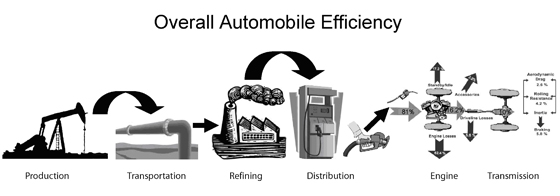3.8: Overall Efficiency
- Page ID
- 48769
Calculating Overall Efficiency
Using the energy efficiency concept, we can calculate the component and overall efficiency:
\[ Overall \, Efficiency = \dfrac{Electrical \, Energy \, Output}{Chemical \, Energy \, Input} \]
Here the electrical energy is given in Wh and Chemical Energy in BTUs. So Wh can be converted to BTUs knowing that there are 3.412 Wh in a BTU.
This overall efficiency can also be expressed in steps as follows:
\[ Overall \, Efficiency = \underbrace{ \left\lbrack \dfrac{Thermal \, Energy}{Chemical \, Energy} \right\rbrack }_{Boiler \, Efficiency} * \underbrace{ \left\lbrack \dfrac{Mechanical \, Energy}{Thermal \, Energy} \right\rbrack }_{Turbine \, Efficiency} * \underbrace{ \left\lbrack \dfrac{Electrical \, Energy}{Mechanical \, Energy} \right\rbrack }_{Generator \, Efficiency} \]
\[ OverallEfficiency = \eta_{boiler} * \eta_{turbine} * \eta_{generator} \]
Steps of Overall Efficiency
We have been looking at the efficiencies of an automobile or a power plant individually. But when the entire chain of energy transformations is considered—from the moment the coal is brought out to the surface to the moment the electricity turns into its final form—true overall efficiency of the energy utilization will be revealed. The final form at home could be light from a bulb or sound from a stereo. The series of steps are:
- Production of coal (mining)
- Transportation to power plant
- Electricity generation
- Transmission of electricity
- Conversion of electricity into light (use)
The following video discusses overall power plant efficiency.
Efficiency of a Light Bulb
If efficiency of each step is known, we can calculate the overall efficiency of production of light from coal in the ground. Table 3.8.1 illustrates the calculation of overall efficiency of a light bulb.
Table 3.8.1. Calculation of overall efficiency of a light bulb
| Step | Step Efficiency | Cumulative (Overall) Efficiency |
|---|---|---|
| Extraction of coal | 96% | 96% |
| Transportation | 98% | 94% = (0.96 * 0.98) * 100% |
| Electricity generation | 35% | 33% = (0.94 * 0.35) * 100% |
| Transmission of electricity | 95% | 31% = (0.33 * 0.95) * 100% |
| Lighting: incandescent bulb | 5% | 1.56% = (0.31 * 0.05) * 100% |
| Lighting: fluorescent bulb | 20% | 6.2% = (0.31 * 0.20) * 100% |
Efficiency of an Automobile
A similar analysis on automobile efficiency is shown in Figure 3.8.1.

Figure 3.8.1. Overall automobile efficiency
Table 3.8.2 shows that only about 10% of the energy in the crude oil in the ground is in fact turned into mechanical energy moving people.
Table 3.8.2. Automobile efficiency
| Step | Step Efficiency | Cumulative/Overall Efficiency |
|---|---|---|
| Extraction of crude oil | 96% | 96% |
| Refining | 87% | 84% |
| Transportation | 97% | 81% |
| Engine | 25% | 20% |
| Transmission | 50% | 10% |

